Table of Contents[Hide][Show]
A nourishing homemade baby formula using safe, whole ingredients. This recipe was developed and tested by Dr. Mary Enig, a PhD Nutritionist and originally published in Nourishing Traditions cookbook in 1996. It was formulated to match breastmilk as closely as possible and is also suitable for infants. Source: Weston A. Price Foundation
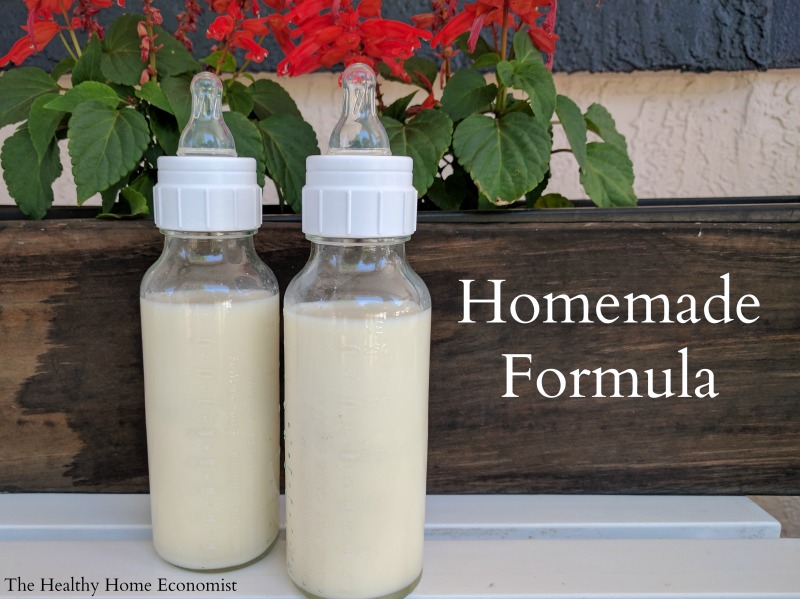
There is no doubt that breastfeeding your baby is the best option for the child’s long-term health and development. Human breastmilk from a well-nourished mother is the perfect food for baby. However, in circumstances where the child is adopted or the Mother finds herself unable to breastfeed, formula feeding becomes necessary. In those cases, homemade baby formula is best.
Using a baby formula recipe that closely matches the nutritional profile of breastmilk is a far better choice than even organic baby formula from the health food store. More on this below.
Note: Donor programs are widely available for human breastmilk. But, the diets of the donor mothers are unknown and most likely nutritionally insufficient. In addition, breastmilk banks pasteurize the donated breastmilk which destroys much of the nutritional benefit. Unless you are fortunate to have a trusted and direct donor milk source in your community, avoid this option!
Dangers of Commercial Formula
Commercial formulas are always a poor choice for a number of reasons. First of all, formula manufacturers line the cans with the chemical BPA. This substance disrupts hormone development and is a probable contributor to early puberty in girls, and ADHD, urogenital abnormalities, and other ills in boys.
The European Food Safety Authority found that canned commercial formula is a significant source of BPA for infants, exposing the child to 13mcg of BPA per kg of body weight per day! BPA-free formula cans are no better. The chemical BPS is typically used instead which is just as dangerous.
Beware that manufacturers pack even organic commercial formula like Earth’s Best in BPA cans. Worse, they use organic brown rice syrup as the primary sweetener which is known to be frequently contaminated with arsenic.
In addition, all commercial milk formulas are processed at extremely high temperatures which violently denature the fragile milk proteins, render them allergenic, and add carcinogens to the final product. Soy infant formula is the worst. Obscenely high processing temperatures not only denature the proteins but large levels of phytic acid in soy block mineral absorption by the infant. Moreover, soy-based plant estrogens disrupt the hormonal development of the baby!
It seems that for the concerned Mother who is unable to breastfeed, learning how to make baby formula at home with safe, pure ingredients is the most prudent way to go!
Why Make Homemade Formula Even if You Are Breastfeeding
In the video below, I show you how to make your own safe, healthy raw milk homemade formula for your baby.
The recipe I follow was originally published in the cookbook Nourishing Traditions in 1996 and developed by Dr. Mary Enig.
Even though I breastfed each of my children for at least 2 years, I made this exact formula for my own children when I was away for the day or the evening as pumping was not an option that worked well for me.
I even used this homemade formula for an entire day once when I had some dental work done and was advised to pump and discard for 24 hours.
As a result, even successfully breastfeeding Moms can use this wonderful homemade formula as a supplement when necessary to their own nutrient-dense breastmilk!
It is advised that even breastfeeding Mothers have the ingredients for this formula on hand for an emergency. If Mom is sick or otherwise unable to nurse, Dad can step in and make this safe alternative until Mom is back on her feet. It takes a few days to a week to gather all the ingredients together to make this formula, which is why I advise having them on hand at all times.
Homemade Most Nutritious
The image below lists the reasons why it is worth it nutritionally to make formula yourself for your precious baby!
You can order all of the required ingredients for the homemade baby formula in one package from this reputable, vetted source.
Moms who have successfully used this formula feeding your children, please post about your experience in the comments section to encourage those who are considering it and need some Mom to Mom encouragement!
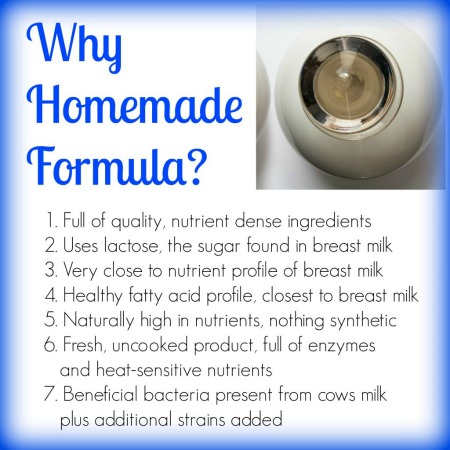
Where to Source Quality Milk
The most widely available grass-fed milk around the world is from cows. This is usually the most budget-friendly and easily sourced milk for this recipe for homemade formula.
If only goat milk is available in your area, this recipe for goat milk baby formula can be used instead. When using milk from ewes, please refer to the linked article for an adjusted recipe; one of the benefits of sheep milk is that it is higher in healthy fats than either goat or cow milk.
Camel milk formula is another option that is a particularly digestible form of dairy and growing in popularity around the world.
Alternatively, you can use low temp (vat) pasteurized, non-homogenized whole milk cultured with a piima or kefir starter. Then substitute the piima milk or kefir for the raw milk portion of the formula recipe. Cold-pressed raw milk also must be cultured before using it as it contains no probiotics.
Do NOT use ultrapasteurized (UHT) milk even if organic as it is too highly processed and extremely allergenic!
It is also best to avoid all types of powdered milk for this recipe. The factory process of making milk powder reduces nutrition considerably and denatures it, which makes it more likely baby will have an allergic reaction.
Dairy Allergy Option
If all types of dairy prove unsuitable for your baby, make this nondairy baby formula recipe instead. It uses a base of homemade bone broth as a substitute for milk. It is important not to utilize a plant-based or otherwise vegan baby formula recipe.
Avoid buying bone broth to make the dairy-free formula. Make it yourself! Manufacturers of commercial bone broth, even if authentic, may water down the end product. This is apparent if it does not gel when chilled in the refrigerator.
Many brands have toxic packaging issues as well. If you must buy it in a pinch, see my shopping guide page for vetted brands that are safe.
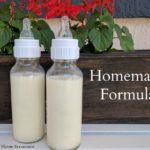
Homemade Baby Formula Recipe (for infants too)
A nourishing baby formula recipe you can make at home with safe, whole ingredients developed and tested by a PhD nutritionist to match breastmilk as closely as possible. Also suitable for infants.
Ingredients
- 2 cups raw cow milk OR organic whole milk yogurt
- 1 7/8 cups filtered water
- 1/4 cup liquid whey
- 4 Tbl lactose
- 1/4 tsp Bifidobacterium infantis powder
- 2-4 Tbl raw or pasteurized cream
- 1/2 tsp cod liver oil unflavored
- 1/4 tsp butter oil unflavored
- 1 tsp sunflower oil preferably organic
- 1 tsp extra virgin olive oil preferably organic
- 2 tsp virgin coconut oil preferably organic
- 2 tsp nutritional yeast
- 2 tsp gelatin
- 1/4 tsp acerola powder
Instructions
-
Fill a 2 cup Pyrex measuring cup with filtered water and remove 2 TBL (this will give you 1 7/8 cup water).
-
Pour about half the water into a pan and turn burner on medium.
-
Add the gelatin and lactose and let dissolve, stirring occasionally.
-
When gelatin and lactose are dissolved, remove pan from heat and add the rest of the water to cool.
-
Stir in the coconut oil and butter oil until melted.
-
Put remaining ingredients in a glass blender.
-
Add the water mixture and blend for about 3 seconds.
-
Place formula in glass baby bottles or a glass jar and refrigerate.
-
Before giving to baby, warm glass bottle in a pan of hot water or a bottle warmer. NEVER microwave baby bottles!
Recipe Video
Recipe Notes
If using raw cow milk from holstein cows, use 4 Tbl of extra cream (otherwise use 2 Tbl extra cream).
If choosing to make this homemade formula with camel milk, be sure to include 4 Tbl extra cream as camel milk is lower in cream than cow milk.
Do not use high oleic sunflower oil. Use only the brand recommended in the ingredients list which is cold pressed, organic, unrefined, and low oleic.
*Do NOT use powdered whey from the store as it is denatured. Avoid whey from making cheese as it will curdle the formula.
*Do not substitute pasteurized or powdered milk as these are heavily processed, denatured and allergenic foods.
*Do NOT use ultrapasteurized (UHT) cream. It is highly allergenic. Raw or pasteurized cream is acceptable.
*Do NOT use fish oil or krill oil instead of high vitamin cod liver oil as they do not contain any Vitamin D and very little to no Vitamin A.
Collagen powder may be substituted for the gelatin in a pinch (more on peptides in baby formula in this article).
If you are wondering where is the iron in homemade baby formula, this article provides an explanation.
If baby experiences constipation using this formula, try adding 1 tsp of molasses to each batch. This should help move things along.
How to Transition to DIY Formula
Once you’ve viewed the video, gathered the ingredients, and made your first batch, how do you feed it to your baby for the first time?
It is important not to switch all at once as this can cause gas, excessive spit-up, or an uncomfortable change in diaper habits such as constipation or overly loose stools.
Start by giving your baby three-quarters of the old formula blended with one-quarter of the homemade. Try this ratio for a day or two and see how your infant responds.
If no digestive upset or major change in diaper habits occurs, increase the amount to a 50-50 blend of old formula to homemade. Observe for another day or two as before.
If no major issues, increase once again to three-quarters homemade formula to one-quarter old formula. If baby does well on this blend for a third time, you are ready to fully transition to the homemade formula.
At any time during the transition, symptoms of intolerance emerge, back up to the previous successful blend ratio and stay there for a day or two before attempting to increase once again.
Homemade Formula FAQ
Weston Price Foundation
Feeding an Adopted Baby
Traveling Tips with Baby Formula Made at Home
Iron in Baby Formula
Collagen Peptides instead of Gelatin for Homemade Formula?


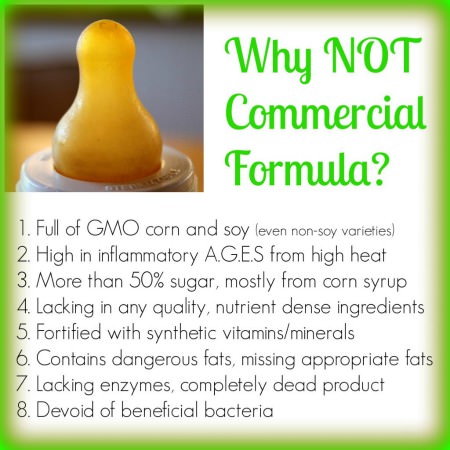
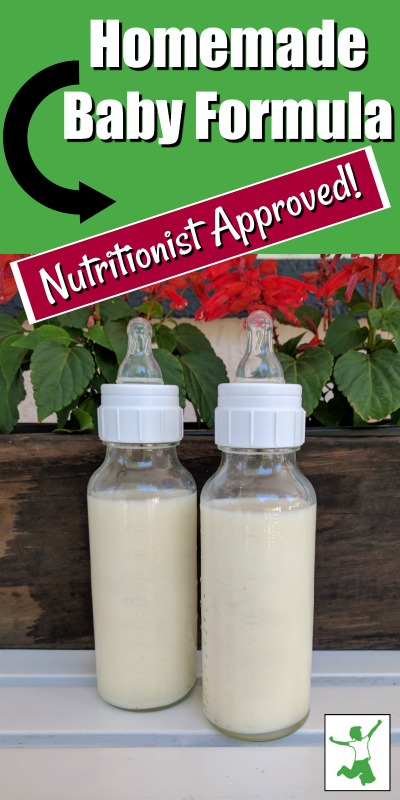






“Some” organic commercial formulas are packed in BPA cans. Not all. I would prefer to make it myself if for some reason I couldn’t breastfeed. THANKS for Sharing your knowledge & experience with others! I signed up for the Newsletter. You have a very informative interesting site. I will refer new Moms or Breastfeeding Moms in general to your site for information.
Hi there
I am new to your blog and finding a bit difficult to find infos… shortly..
I live in Australia – no raw milk country – it is actually illigal!! (unbeleivable i know..)
the point… I been starting to make homemade formula however.. the best milk found is still pastaurized at low tep but pastaurized – i live in the tropic so hot and humid – how can i safely reculture the milk? And what about cream? Baba only has the formula 2 nights a week when im working….
I was wondering if you think the biokult infant probiotic is fine to use with the baby formula.
Yes, should be fine. This product was not available at the initial writing of this post which is why it isn’t mentioned.
Our little one loves this formula. And we tried several different types to find one thst he would eat. However, we are having major issues with constipation. Any recommendations?
Dear Sarah,
We really like your work and approach to health through nutrition. We are following your advice for our 5 mo old twins and they are doing great!
I have a new question for you. We are looking for a naturopatic doctor for our twins. Someone aligned with your way of approaching health and nutrition. We live in Berkeley, CA. Do you have any advice?
If this is not a right question for this blog, I understand. Could you then email me with a suggestion if you have any?
Thanks a lot again and again!
Marina
No idea sorry. I live in Florida.
Hello,
I have one other questions. I have looked everywhere in my area for raw cream and I cannot find it anywhere. The farm where I get my milk does not have it for sale so I have been using “organic valley heavy cream” is this okay to use with the cows milk formula? Or do you recommend another brand?..I’ve been using 2tbsp per batch.
Unfortunately, I am pretty sure the Organic Valley heavy cream is ultrapasteurized which would not be good at all for the homemade formula. You can skim the cream off the top of the raw milk and use that instead. Don’t use the skimmed raw milk for the formula though. Use a fresh raw milk gallon with the cream intact.
Dear Sarah,
We are giving to our boys the formula based on goat’s milk. They are 5 months old now and we know that we can feed them egg yolk and beef liver (we have it in powder from Radiant Life). Any suggestion on how to prepare it and how much to give to them daily?
Thanks for your work and presence in the net!
Marina
Here’s my article on video how-to if that helps: https://www.thehealthyhomeeconomist.com/video-first-food-for-baby/
I don’t have the time to comb through the 600+ comments, so I apologize if my question is redundant. I will need to formula feed my baby (through surrogacy) after my surrogate’s breast milk supply dries up. I have an intense coconut oil allergy which I am concerned may be passed to my child (my mother & sister are both allergic to coconut as well).
Is there a way to safely replace the coconut oil in the various formula recipes without sacrificing the nutritional benefits?
You could probably substitute palm kernel oil (NOT palm oil). Palm kernel oil has the most similar fatty acid profile of any other fat to coconut oil.
Thank you! I’ve read the hype about the unsustainable harvesting for Palm Oil (& consequentially Palm Kernel OiI). Are you aware of any companies that produce sustainably sourced PKO?
BTW – I do plan to do a coconut patch test before starting formula – who knows, maybe coconut will be okay after all.
I appreciate all your advice.
Hello,
I recently tried the meat based formula for my now 6 week old daughter. She’s had it here and there for supplementation purposes for the last two weeks. She seems to do well on it aside from the fact she has very wet BMs. Is this normal?
It takes a couple of weeks for a baby to adjust to a new formula. So if it was a recent change, you might still see some variability.
Can I use this milk to make the formula? organicvalley.coop/products/milk/grassmilk/
How about the kefir?
Unfortunately no. It is pasteurized … aka “dead milk”.
Hi Sarah,
I make my formula fresh everyday but seeing how the formula makes 36 ounces, I only use 30oz. Can that extra 6 ounces be used the next morning or should I throw it away and only use the fresh batch made that day?
You can use it the next morning. Fresh every day is best but overlapping by a few hours to a full day is fine. Otherwise, have some made and frozen in the fridge for emergencies.